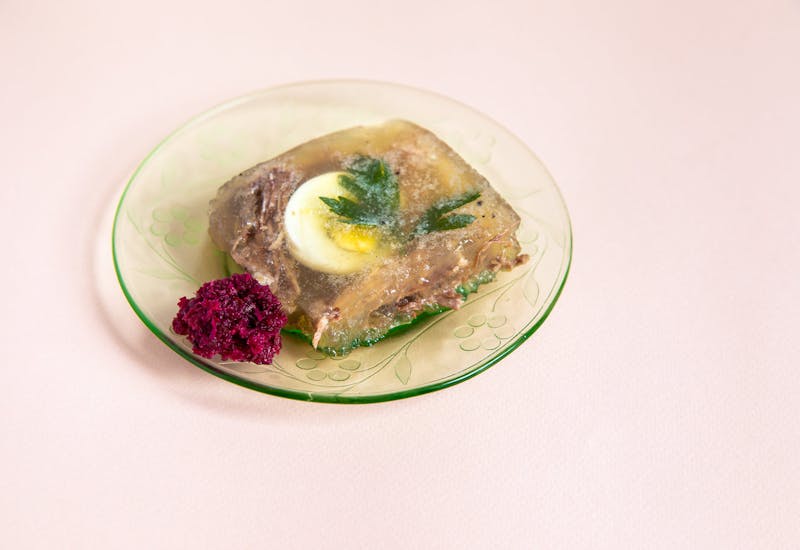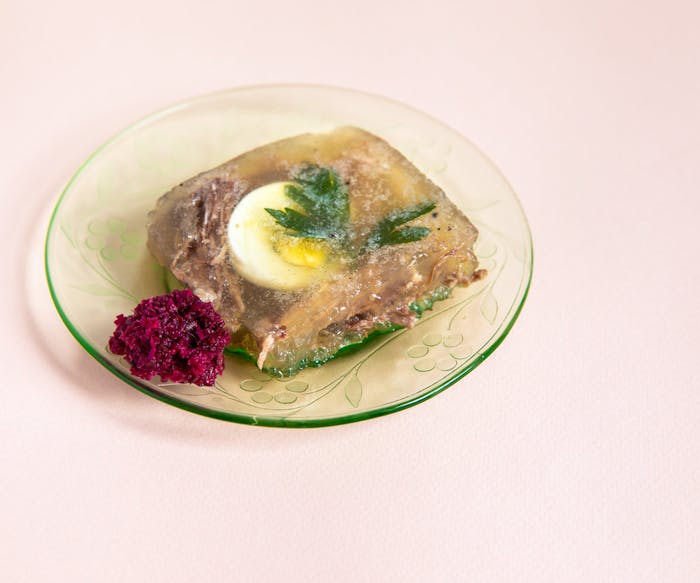For Jews with Eastern European roots, p’tcha is a controversial and divisive dish. A glistening aspic made with the hoof of a calf or cow, seasoned with garlic, it’s an acquired taste and texture, equally beloved and despised, depending upon who you’re speaking to. For Darra Goldstein, a scholar of Russian literature and a cookbook author, the dish is both dream and nightmare.
When she was growing up in Pittsburgh and Chicago, p’tcha held an almost mythical place in her family. It was talked of longingly by her mother Helen and grandmother Clara, who grew up in a shtetl near Vitebsk, in modern day Belarus, with Marc Chagall. Clara’s father owned a butcher shop, that, as the family lore goes, was always filled with local children playing. Somehow, the magic of Chagall’s painting, the lore of the butcher shop, and the remembrances of p’tcha were all strung together into a beautiful memory — something recollected fondly, but never served at the dinner table.
The first time Darra encountered it, she was 21, visiting the Soviet Union during the Brezhnev Era, when there was little food on the shelves of supermarkets. Still, Darra’s hosts wanted to impress her. From table to table, she saw kholodets, a treyf cousin of p’tcha sometimes made with pig’s hooves instead of cow’s. Despite the change in ingredients, Darra recognized the dish from her family’s stories.
A decade later, while working on her first cookbook, A Taste of Russia, Darra wanted to include a recipe for the dish. She searched for calf’s feet in Palo Alto, where she was living, to no avail. She told her mother about her mission and on a visit, Helen found a slaughterhouse that agreed to provide the hooves. When they went to pick them up, they were still warm, sticky with blood and gore. Unable to bring themselves to clean the hooves, they were dropped at a landfill.
Back in California, Darra accepted that she would need to test the recipe with pork trotters. Carrying them home in a red canvas backpack on her bike, she started to feel uneasy, overcome by the physical and metaphorical weight of the six pounds of treyf on her back. Still, she was determined. She committed to testing the recipe quickly and then disposing of it. At three in the morning, she woke up to a nightmare of pigs flying around her cottage. In the morning, she reluctantly finished the recipe, tasted it, and disposed of the rest. The recipe appeared in the book, but the experience left an emotional scar behind.
Recently, almost 40 years later, while working on a new Russian cookbook, Darra was faced with the challenge of making p’tcha again. Once again, she struggled to find calf’s feet, but this time she succeeded and invited friends over to try the recipe. “I was so nervous,” she says. “I had built it up so much.”
The result, however, was what she had imagined all of these years. It was firmer, and glistened less but, as Darra explains, “It made me think about my mother, whom I lost almost five years ago, and how I would like to make it for her.”


